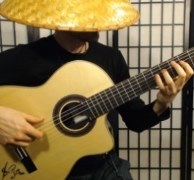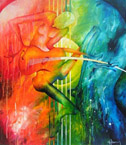Welcome to one of the most active flamenco sites on the Internet. Guests can read most posts but if you want to participate click here to register.
This site is dedicated to the memory of Paco de Lucía, Ron Mitchell, Guy Williams, Linda Elvira, Philip John Lee, Craig Eros, Ben Woods, David Serva and Tom Blackshear who went ahead of us.
We receive 12,200 visitors a month from 200 countries and 1.7 million page impressions a year. To advertise on this site please contact us.
|

|
|
1st position
|
You are logged in as Guest
|
|
Users viewing this topic: none
|
|
Login  | |
|

   
Erik van Goch
Posts: 1787
Joined: Jul. 17 2012
From: Netherlands

|
 RE: 1st position (in reply to rickm) RE: 1st position (in reply to rickm)
|
|
|
The positions you refer to indicate the fret your INDEX is supposed to cover, and as such indicate the position were your left hand is located
The left hand fingers are numbered
1-index finger
2-middle finger
3-ring finger
4 -little finger
As a rule each finger primary covers it's individual fret so 1th finger primary covers 1th fret, 2th finger primary covers 2rth fret, 3th finger.....
Lets say you use those 4 fingers in that order to play a chromatic line (fretting 4 neighboring frets on the same string):
-1-2-3-4----- (you can pick any string or any position you want).
Depending on were your hand is located these fingers can cover al parts of the guitar, but in any fixed position only a limited amount of frets/notes are in reach.
If your hand is in the 1st position (meaning the index is covering the first fret) the 4 fingers chromatically cover fret 1,2,3,4 .
If you shift your hand 1 fret to the right and play the same thing starting with your index finger on the 2th fret you are playing in the so called 2th position and as a result your fingers will not cover fret 1,2,3,4 but fret 2,3,4,5 (and all the notes will sound half a note higher than in the 1th position).
If you play the same 1,2,3,4 fingering starting with your index on the 3th fret you play in the so called 3th position (covering frets 3,4,5,6) and so on and so on.
As you see the basic (index based) fingering 1,2,3,4 only covers a limited amount of frets in any given position....which frets are in reach depends on the position your left hand takes....
in 1st position they chromatically cover fret 1,2,3,4
in 2th position they chromatically cover fret 2,3,4,5
in 3th positioin they chromatically cover fret 3,4,5,6
in 4th position they chromatically cover fret 4,5,6,7
etc.etc.
The position is named after the fret that is covered by your index, so 9th position covers fret 9,10,11,12 starting with the index. Obviously you are not restricted to chromatic lines and single strings but are welcome to play melodies, chords or reach higher parts of the guitar with the other fingers by stretching your hand...with the index on 3th fret your little finger can for instance cover frets 4,5,6,7,8 (depending on the situation)... you still call it 3th position based on the location of the index finger.
Beware that the index can (temporary) leave it's natural position to serve greater goods as well
Dm:
--1--------1th finger index
--3--------3th finger ring
--2------- 2th finger middle
--0-------
-----------
-----------
in above D-minor every finger covers it's own natural habitat (first finger covers 1th fret, second finger 2th fret, 3th finger 3th fret)
If we change to D-mayor (which includes 2 notes that have to be fretted at 2th fret) one finger has to leave it's natural position to cover the 2th 2th fret. The most natural lineup in D major is achieved with this fingering.
D-major
--2--------2th finger middle
--3--------3th finger ring
--2------- 1th finger index
--0-------
-----------
-----------
In above setup finger 2 and 3 still cover there natural territory (the middle finger has changed string but remained in it's natural territory). Only the index has left it's natural territory to support the second finger. Despite the fact the index finger is covering the 2th fret we don't call it 2th position in this situation, because it's natural territory would still be the 1th fret (it is temporary supporting an other finger).
But i would call it 2th position when both 2th frets were covered by the index in half barree, leaving the ring and little finger for additional coloring.
--2--------1th finger index
--3--------2th finger middle
--2------- 1th finger index
--0-------
-----------
-----------
It is this line of thinking (were do i need my fingers and how can they cooperate the best possible way connecting past,precent and future) that makes you choose a certain position.
***************************************************
A clear example of how a position is linked to the natural lineup of the fingering is this famous soleares theme where the chromatically shifting chord is covering 3 positions.
..1th......1th.....3th....2th....1th......1th
--0--------0------0------0------0-------0---------------------------------
--0--------1------3------2------1-------0------(b string al fretted by the index)
--1--------2------4------3------2-------1---------------------------
--2--------3------5------4------3-------2-------------------------------
---------------------------------------------------------------------
---------------------------------------------------------------------
As far as reading partitures are concerned above position-marks are usually annotated in roman figures like I,II,III,IV,V etc.
so if you read
..III
---0-------
---3------
---4-------
---5---------
-------------
-------------
III tells you that the 3th fret is covered by your index
..III
---0-------
---3--- index finger
---4---- middle finger
---5---- ring finger
-------------
-------------
If it says II in stead it indicates the index theoretically covers the (un-frettet) 2th fret and the aimed fingering is
...II
---0-------
---3------middle finger
---4------ring finger
---5------little finger
-------------
-------------
Obviously not the most logic fingering in above soleares but i show it anyhow to demonstrate what i mend with "it's the position your index is supposed to cover".
Obviously there's more to say but this basically covers your question. I probably put to much accent on the index part (it's the overall natural hand position that decides how to call a position) but in the majority of cases the position of the index is indeed leading.
|
|
|
|
REPORT THIS POST AS INAPPROPRIATE |
Date Feb. 26 2013 21:48:37
 |
|

   
Ricardo
Posts: 14797
Joined: Dec. 14 2004
From: Washington DC

|
 RE: 1st position (in reply to rombsix) RE: 1st position (in reply to rombsix)
|
|
|
quote:
ORIGINAL: rombsix
I think both Erik and myself are talking about the term "left hand position" but this stands for two things.
Quoting from wikipedia:
"Left-hand position
In the left hand, each finger is responsible for exactly one fret. For each hand-position of four frets, the left hand is stationary while its fingers move. Consequently, three hand-positions (of frets 1-4, 5-8, and 9-12) cover the 12-fret octave of each string.[8]
In common with other classical stringed instruments, classical guitar playing and notation use formal positions of the left hand. The 'nth position' means that the hand is positioned with the first finger over the nth fret."
No, erik is correct and if I were you I would revise my understanding of the term and usage. What you describe is actually 1st position, 5th postition, and 9th positition, respectively. Guitar players of all styles would understand this as such, not just classical. Although it is the classical school mainly that deals with scores, such that Roman Numerals indicate positions of frets. A big C next to Roman numerals means you barre that fret position, and A C with a line through means you half barre (more common in flamenco especially if you have open strings under the barre).
To understand why whatever that "3 positions" concept is about is not logical, what would call then playing frets 4-7?? Makes no sense so I would just scrap even that whole idea. I think the description is simply talking about how much room on the neck there is, not actually playing. They imply that if you only know postion 1, 5, and 9 it would allow access to the entire fingerboard after which you have octave repeat of patterns known. That is quite an incomplete picture however true, and probably arbitrary to even mention when talking about positions.
Ricardo
_____________________________
CD's and transcriptions available here:
www.ricardomarlow.com
|
|
|
|
REPORT THIS POST AS INAPPROPRIATE |
Date Feb. 27 2013 14:38:10
 |
|

   
rombsix
Posts: 7805
Joined: Jan. 11 2006
From: Beirut, Lebanon

|
 RE: 1st position (in reply to Blondie#2) RE: 1st position (in reply to Blondie#2)
|
|
|
The reference I am talking about is used when referring to the fretboard as the first part, middle part, and last part (looking at the 12th fret as being the "end" of the fretboard). This is usually used in classical guitar teaching, especially when teaching students the notes on the neck, whereby the most commonly used notes when starting out learning are in the "first position" meaning frets 1 through 4, then "second position" meaning frets 5 through 8 where you would move to introducing notes on the fretboard when the student starts learning a bit more advanced pieces, and then "third position" meaning frets 9 through 12 where you would move to introducing notes on the fretboard when the student starts learning even more advanced pieces.
I'm not saying this is the best terminology, and I understand/know the information you mentioned above. All I'm saying is that I've heard of this being taught in Lebanon (with people having learned guitar from mostly European countries), and the fact that it is also mentioned on wikipedia means other people use it too. I'm not saying this is the most logical concept, but I'm just saying that the "first position, second position, third position" concept can have two meanings.
It's not a huge deal, really.
Cheers!
_____________________________
Ramzi
http://www.youtube.com/rombsix
|
|
|
|
REPORT THIS POST AS INAPPROPRIATE |
Date Feb. 27 2013 17:37:02
 |
|
 New Messages New Messages |
 No New Messages No New Messages |
 Hot Topic w/ New Messages Hot Topic w/ New Messages |
 Hot Topic w/o New Messages Hot Topic w/o New Messages |
 Locked w/ New Messages Locked w/ New Messages |
 Locked w/o New Messages Locked w/o New Messages |
|
 Post New Thread
Post New Thread
 Reply to Message
Reply to Message
 Post New Poll
Post New Poll
 Submit Vote
Submit Vote
 Delete My Own Post
Delete My Own Post
 Delete My Own Thread
Delete My Own Thread
 Rate Posts
Rate Posts
|
|
|
Forum Software powered by ASP Playground Advanced Edition 2.0.5
Copyright © 2000 - 2003 ASPPlayground.NET |
0.078125 secs.
|


 Printable Version
Printable Version






 I don't have any material to cite at this moment. This doesn't change what I stated earlier though.
I don't have any material to cite at this moment. This doesn't change what I stated earlier though.  I'm not arguing. I'm just saying that some people use the concept the way I stated it too - nothing more.
I'm not arguing. I'm just saying that some people use the concept the way I stated it too - nothing more. 


 New Messages
New Messages No New Messages
No New Messages Hot Topic w/ New Messages
Hot Topic w/ New Messages Hot Topic w/o New Messages
Hot Topic w/o New Messages Locked w/ New Messages
Locked w/ New Messages Locked w/o New Messages
Locked w/o New Messages Post New Thread
Post New Thread